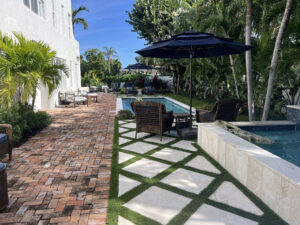Creating your dream pool is not only making a water-filled body in the backyard; it is much more—it’s an artistic blend of creativity infused with design elements that reflect your personal choices and lifestyle. A pool enhances your outdoor living space and promises days and nights of swimming fun and entertainment.
From high-end texture finishes to brightly colored tiles, elegant modern pool fittings, and carefully selected pool accessories, every detail attended to by your pool builders contributes to the pool’s overall visual appeal. These elements are aesthetically placed to personalize the space and elevate its style to make a bold statement of modernity, innovation, and taste.
Why Pool Resurfacing Is Essential for Safety and Longevity
Even with diligent maintenance and regular care, the surface of a swimming pool starts to give way- inevitably deteriorating over time such that pool repair becomes essential. This happens because of:
1. Harsh chemicals
2. Fluctuating weather conditions
3. Environmental exposure
4. Natural aging processes
All these factors contribute to pool surface degradation and result in uneven flooring, rough textures, discoloration of tiles, deep dark stains, cracks, and even leaks in the pool walls and flooring. Extensive pool cleaning may also be of no help at this stage, and people often have to deal with unsightly pool stains until they decide to replaster the pool.
Even with regular pool maintenance, it can sometimes be hard to tell whether you’re dealing with stubborn staining or true surface damage. Either way, worn textures, discoloration, and deep stains can take away from the beauty and safety of your pool.
If maintenance efforts aren’t restoring your pool’s appearance, it may be time to consider pool resurfacing to protect your investment and keep your swimming environment in top shape.
The Importance of Pool Resurfacing
1. A damaged pool surface is more than an eyesore. It can cause a mishap and is a serious hazard if left unaddressed. Uneven or chipped pool surfaces increase swimmers’ risk of injuries and accidents.
2. Timely pool resurfacing ensures longevity and restores the pool’s visual appeal by reinforcing its structural integrity, creating a smoother and safer swimming environment.
3. While regular cleaning and upkeep are essential, they aren’t always enough to preserve the surface. Pool maintenance can keep the pool water clean and the walls stain-free. But, over time, even the best maintenance equipment cannot shield the pool flooring and walls from wear and tear. Long-term pool care is incomplete without pool resurfacing.
4. Pool services clean the pool regularly, and they can notice the subtle textural changes occurring on the pool flooring and walls. Before significant damage occurs, skilled professionals advise resurfacing the pool to ensure it remains beautiful and functional for years.
5. Is it easy to craft the perfect pool design that transforms its whole look? Even if this task seems to be an ordeal, it’s not! You can hire professionally trained people to transform the pool and make it visually stunning with resurfacing!
6. Whether it’s brightly colored tile, the infinity edge, or subtle hues, make the choice and get these renovations or remodeling done when the pool resurfacing is planned so that there is no extra expenditure on the accessories later. It’s the perfect time to enhance beauty and pool longevity through resurfacing and pool remodeling.
How Is Pool Resurfacing Done?
Over time, even the strongest pool surfaces start to show wear. Stains, cracks, and rough textures often develop after about 10–15 years of use. When that happens, pool resurfacing isn’t just about making the pool look good again—it’s critical for keeping the structure safe and extending the life of your pool.
Step 1: Remove the Old Surface
Resurfacing starts by removing the old, damaged material. Whether it’s aged plaster, worn Diamond Brite, or an older PebbleTec finish, it needs to be properly stripped away using professional-grade tools. Careful surface preparation is key to making sure the new finish bonds correctly.
Step 2: Prep the Pool for the New Surface
After the old surface is removed, the pool shell is pressure-washed and cleared of dust, debris, and leftover residue. Any cracks or hollow spots are patched. Getting the surface perfectly clean and solid is one of the most important steps to guarantee a smooth, long-lasting resurfacing job.
Step 3: Choose Your New Finish
Today’s pool owners have more options than ever. Standard white plaster is still common, but many people upgrade to finishes like Diamond Brite or PebbleTec for extra durability, texture, and style.
Diamond Brite combines natural quartz aggregates with polymer-modified cement for a stunning, long-lasting finish that resists staining. PebbleTec offers a more natural look with exposed pebbles and is known for extreme durability under heavy use.
Pro Tip: Choosing Between Diamond Brite and PebbleTec
If you’re planning your pool resurfacing, one of the biggest decisions you’ll make is the finish.
Diamond Brite is a fantastic choice if you want a smooth, polished look that’s durable and stain-resistant. It’s available in a wide range of colors and holds up well even under heavy use.
PebbleTec is ideal if you’re aiming for a more natural, lagoon-style appearance. It’s made with exposed pebbles and is extremely tough, making it one of the most durable finishes on the market.
Not sure which is right for you? Contact Finn’s Pool Services—we’ll walk you through the options and help you pick the perfect finish for your style, budget, and long-term needs.
Step 4: Apply the New Surface
The new surface material—whether plaster, quartz, or pebble—is expertly troweled onto the pool by hand in multiple layers. Skilled technicians work carefully to create an even, seamless finish that’s smooth to the touch and visually flawless. After the application, the surface is cured and then chemically balanced to prepare the pool for swimming.
Step 5: Cure and Protect
Proper curing is critical. New plaster or exposed aggregate surfaces go through a 30-day curing process where the pool water chemistry needs to be closely monitored and adjusted. This helps protect the new finish and ensures it hardens properly for maximum lifespan.
Contact Finn’s Pool Services to customize your pool surfaces and get your choice of patterns, colors, and textures. You can even ask for anti-slip features to be added while pool resurfacing is done so your loved ones can enjoy their swimming sessions safely!



